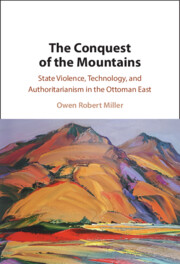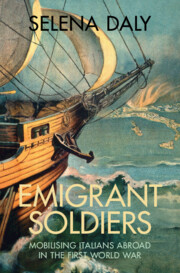Refine search
Actions for selected content:
49 results

The Conquest of the Mountains
- State Violence, Technology, and Authoritarianism in the Ottoman East
-
- Published online:
- 14 November 2025
- Print publication:
- 11 December 2025
20 - The seventh continent: Russian territorial expansion, 1450–1850
-
-
- Book:
- The Cambridge History of War
- Published online:
- 18 July 2025
- Print publication:
- 14 August 2025, pp 487-512
-
- Chapter
- Export citation
10 - Conflict in Northeastern Europe and the emergence of Russia to 1721
-
-
- Book:
- The Cambridge History of War
- Published online:
- 18 July 2025
- Print publication:
- 14 August 2025, pp 255-282
-
- Chapter
- Export citation
Chapter 14 - Death and the Limits to State Coercive Power
-
-
- Book:
- Kant's Lectures on Political Philosophy
- Published online:
- 18 July 2025
- Print publication:
- 07 August 2025, pp 256-274
-
- Chapter
- Export citation
4 - Carrying “The Nation’s Thousand-Jin Burden”
-
- Book:
- Grains of Conflict
- Published online:
- 23 August 2025
- Print publication:
- 31 July 2025, pp 150-183
-
- Chapter
- Export citation
Chapter 6 - Sons, Don’t Come Back!
-
- Book:
- Emigrant Soldiers
- Published online:
- 05 June 2025
- Print publication:
- 26 June 2025, pp 122-140
-
- Chapter
- Export citation
Chapter 1 - Sons of Sunny Italy
-
- Book:
- Emigrant Soldiers
- Published online:
- 05 June 2025
- Print publication:
- 26 June 2025, pp 1-29
-
- Chapter
- Export citation

Emigrant Soldiers
- Mobilising Italians Abroad in the First World War
-
- Published online:
- 05 June 2025
- Print publication:
- 26 June 2025
Chapter 13 - National service
- from Part 5 - Force preparation
-
-
- Book:
- Mobilising the Australian Army
- Published online:
- 23 May 2025
- Print publication:
- 30 May 2025, pp 272-296
-
- Chapter
- Export citation
Introduction
-
- Book:
- The Age of Youth
- Published online:
- 27 May 2025
- Print publication:
- 24 April 2025, pp 1-25
-
- Chapter
- Export citation
1 - Uncle Sam’s Khaki University and World War I
-
- Book:
- The Age of Youth
- Published online:
- 27 May 2025
- Print publication:
- 24 April 2025, pp 26-60
-
- Chapter
- Export citation
Chapter 1 - In Time of War
-
- Book:
- The Quest for Individual Freedom
- Published online:
- 12 April 2025
- Print publication:
- 10 April 2025, pp 11-55
-
- Chapter
- Export citation
3 - US Combat Soldiers in Vietnam
- from Part I - Battlefields
-
-
- Book:
- The Cambridge History of the Vietnam War
- Published online:
- 02 January 2025
- Print publication:
- 28 November 2024, pp 83-99
-
- Chapter
- Export citation
Alien control measures and their effect on European born clergy and religious in the Diocese of Salford during the Great War
-
- Journal:
- British Catholic History / Volume 37 / Issue 2 / October 2024
- Published online by Cambridge University Press:
- 23 July 2025, pp. 127-162
- Print publication:
- October 2024
-
- Article
-
- You have access
- HTML
- Export citation
7 - Byzantine and Umayyad Egypt
-
- Book:
- Slavery and Dependence in Ancient Egypt
- Published online:
- 01 March 2024
- Print publication:
- 21 March 2024, pp 343-431
-
- Chapter
- Export citation
Preserving and progressing: Tensions in the gendered politics of military conscription
-
- Journal:
- European Journal of International Security / Volume 9 / Issue 3 / August 2024
- Published online by Cambridge University Press:
- 04 March 2024, pp. 468-490
-
- Article
-
- You have access
- Open access
- HTML
- Export citation
12 - Technology, Military Reform, and Warfare in the Tokugawa-Meiji Transition
- from PART II - Economy, Environment, and Technology
-
-
- Book:
- The New Cambridge History of Japan
- Published online:
- 15 January 2024
- Print publication:
- 23 November 2023, pp 397-440
-
- Chapter
- Export citation
4 - Downsizing, Recruiting and Debates over Military Service
-
- Book:
- Uncertain Warriors
- Published online:
- 19 October 2023
- Print publication:
- 09 November 2023, pp 139-178
-
- Chapter
- Export citation
3 - Grand Hotels at War
-
- Book:
- Big Business and the Crisis of German Democracy
- Published online:
- 19 October 2023
- Print publication:
- 02 November 2023, pp 85-105
-
- Chapter
-
- You have access
- Open access
- HTML
- Export citation
Chapter 7 - Shakespeare and the Survival of Middle England
-
-
- Book:
- Shakespeare at War
- Published online:
- 17 August 2023
- Print publication:
- 17 August 2023, pp 71-80
-
- Chapter
- Export citation
